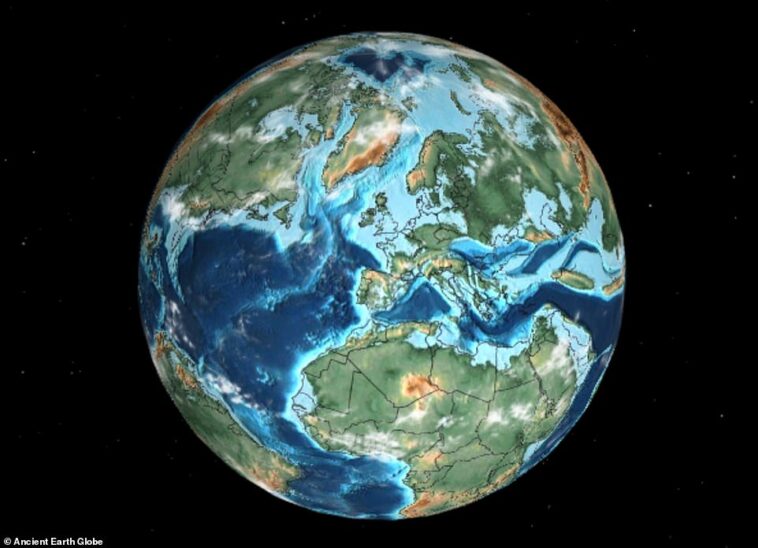Let’s be honest, we’ve all wondered that.
Obviously Britain wasn’t Britain when dinosaurs roamed the earth, but where exactly was your home in the time of T.Rex, Stegosaurus and Diplodocus?
Well, with an interactive map, you can go back in time to find out.
Ancient Earth Globe shows how continents split and reformed as oceans advanced and receded over 750 million years of our planet’s history.
It also includes a number of tools that make it easy to learn more about Earth, such as: B. where the first reptiles lived or when the first flower bloomed.

Earth at the time of the dinosaur extinction: Ancient Earth Globe shows how continents divided and reformed as oceans advanced and receded over 750 million years of the planet’s history. Here is Britain 66 million years ago
The map was created using research from Northern Arizona University and shows that people are “just a fraction of the story,” according to Ian Webster, the former Google engineer behind it.
The website allows you to jump back and forth between the extinction of the dinosaurs and the appearance of the first hominids – the primate family that includes humans and our fossil ancestors.
You do this by entering your location into the map, which then inserts it into plate tectonic models and allows users to do so See where countries were located hundreds of millions of years ago.
For example, you can see where the UK, USA, Europe, Africa, Australia, Russia, India, China and more were located in the time of the dinosaurs.
This includes the Early Triassic Period 240 million years ago to the Jurassic Period 170 million years ago and the Cretaceous Period 90 and 105 million years ago.
At that time, Africa had a vast ocean running along its northeastern edge, while Australia and Antarctica almost touched.
The map also shows what Earth looked like when the dinosaurs were wiped out by a giant asteroid 66 million years ago.
When searching for places, the site’s rotating 3D globe shows where on Earth that area was millions of years ago.
It even shows which dinosaurs lived nearby in the area you are looking for.
For example, Eustreptospondylus was a carnivore that lived in what is now England during the Jurassic period.
Another species of dinosaur, Neovenator, lived in what is now Britain and France.
Summaries of each period show what happened at different stages, such as the early Cambrian period 540 million years ago.
Also of particular interest is the formation of Pangea about 280 million years ago, when the entire landmass of Earth was combined into a single supercontinent surrounded by an ocean, Panthalassa.
The east coast of the United States would have bordered North Africa, while America’s Gulf Coast hugged Cuba.
Mr Webster told MailOnline he created the interactive map as a practical educational tool for younger generations.
“I chose this map because I find ancient history and geology fascinating,” added the software engineer.
“It can be difficult to imagine what the Earth used to look like. Putting this knowledge in a format we are all accustomed to – an interactive globe – goes a long way towards creating a geological history teaching tool.”

The map was created using research from Northern Arizona University and shows that people are “just a fraction of the story,” according to Ian Webster, the former Google engineer behind it. This is what the earth looks like today

The map spans the period from the early Triassic 240 million years ago to the Cretaceous 90 (pictured) and 105 million years ago

It also shows the Jurassic period, 170 million years ago, when dinosaurs thrived and ocean life became more diverse
Webster created the map as a web application that sits on top of another map that visualizes geological models created by geologist and paleogeographer Christopher Scotese.
These models describe plate tectonic evolution 750 million years ago, around the time green algae first evolved in Earth’s oceans.
You can also search what our planet looked like when it got its first shells, coral reefs, vertebrates, land plants and animals, insects and reptiles.
In addition, you can jump to the first grass, to the first hominids, when the supercontinents Pannotia and Pangea existed and when the dinosaurs died out.
Linked to the website is the Dinosaur Database, which is full of facts and figures about the ancient and fearsome creatures that once roamed the earth.

The website even shows which dinosaurs lived nearby in the area you are looking for. For example, Eustreptospondylus (shown in this artist’s rendering) was a carnivore that lived in what is now England during the Jurassic period

Another species of dinosaur, Neovenator (pictured), lived in what is now Britain and France
#home #time #dinosaurs #map





